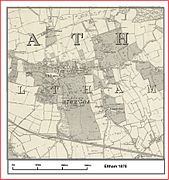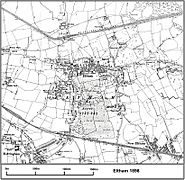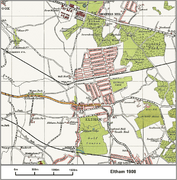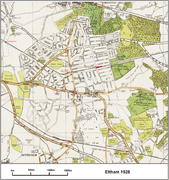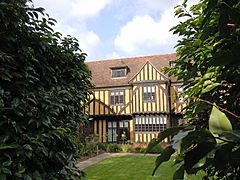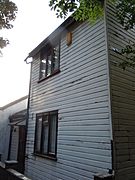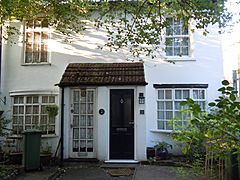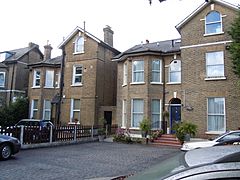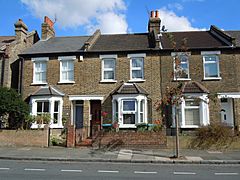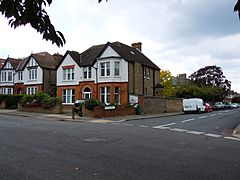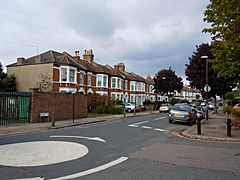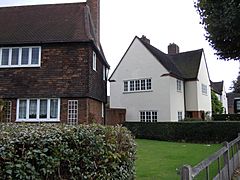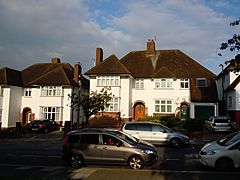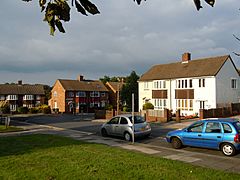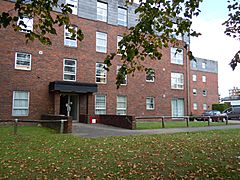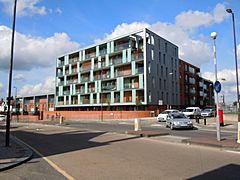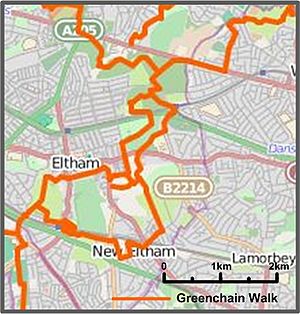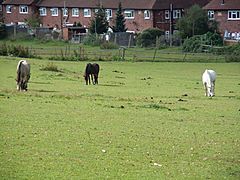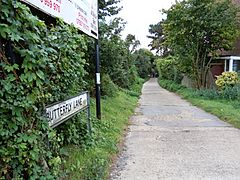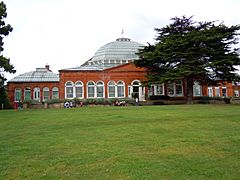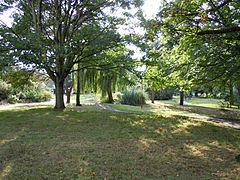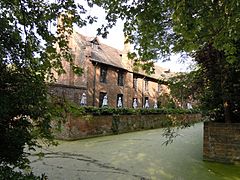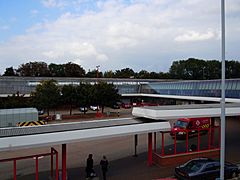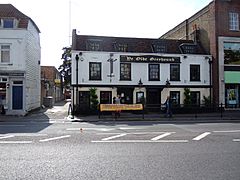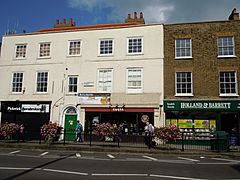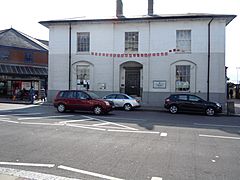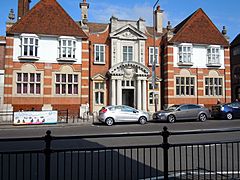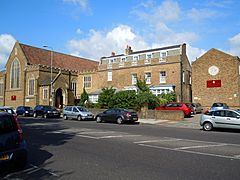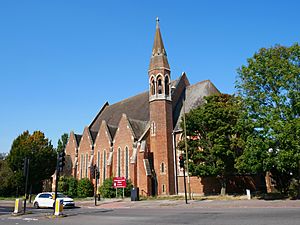Eltham facts for kids
Quick facts for kids Eltham |
|
|---|---|
| Population | 48,964 (2011 Census. 4 Wards. Middle Park and Sutcliffe, Eltham, North, South and West) |
| OS grid reference | TQ425745 |
| London borough | |
| Ceremonial county | Greater London |
| Region | |
| Country | England |
| Sovereign state | United Kingdom |
| Post town | LONDON |
| Postcode district | SE9, SE12 (part) |
| Dialling code | 020 |
| Police | Metropolitan |
| Fire | London |
| Ambulance | London |
| EU Parliament | London |
| UK Parliament |
|
| London Assembly |
|
Eltham is a busy area in southeast London, England. It is part of the Royal Borough of Greenwich. Eltham is about 14 kilometers (8.7 miles) east-southeast of Charing Cross, a famous spot in central London. It is known as one of the 35 main centers in Greater London. The three areas of Eltham North, South, and West have a total population of 35,459 people.
Contents
History of Eltham
How Eltham Began
Eltham grew along a main road that went from London to Maidstone. It is about 5 kilometers (3 miles) south of Woolwich. In the past, a nearby area called Mottingham became part of Eltham.
From the 500s, Eltham was in an old area called the Lathe of Sutton at Hone. In a very old book from 1086, called the Domesday Book, its local area was named Gren[u/v]iz (Greenwich). By 1166, this area was called Blachehedfeld (Blackheath). This was because the main meeting place for the area was there.
Eltham used to have a market on Tuesdays. It also had two fairs each year. But these markets and fairs stopped a long time ago.
By the 1880s, the old areas of Kent were no longer used. New local government areas took over. Eltham was a local area of Kent until 1889. Then it became part of the County of London. From 1900, it was part of the Metropolitan Borough of Woolwich. In 1965, this borough was removed. Eltham then became part of the London Borough of Greenwich.
Today, Eltham is one of the largest suburban areas in the borough. It has a population of almost 88,000 people.
Early Buildings and Growth
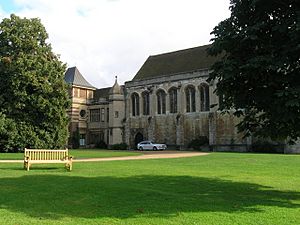
Eltham is on a high, sandy area. This made it a good place for defense. It was also close to the main road to the English Channel ports. Because of this, the famous Eltham Palace was built here. It was a royal palace with a moat around it.
Kings of England had a palace in Eltham very early on. King Henry III spent Christmas there in 1270. He was with the Queen and many important people. Anthony Bec, a bishop, spent a lot of money on buildings here. He died there in 1311. Some say he gave Eltham-house to King Edward II. Edward II often stayed here. In 1315, his son, John of Eltham, was born in the palace. King Edward III held important meetings (Parliaments) at Eltham in 1329 and 1375.
Another important place was Well Hall manor. It was home to Sir John Pulteney, who was the Lord Mayor of London four times. Later, it belonged to William Roper and his wife Margaret. Margaret was the daughter of Saint Thomas More, who worked for King Henry VIII. In 1733, Sir Gregory Page bought this estate. He pulled down the old house and built Page House. This house was later known as Well Hall House. Famous people like watchmaker John Arnold and author Edith Nesbit lived there. It was pulled down in 1931.
Avery Hill Park is also important. It used to have a large mansion. This mansion was home to Colonel North. He became rich from the nitrate industry in Chile. Today, a large greenhouse in the park is open to the public. It has many tropical plants. The mansion is now part of the University of Greenwich. However, the university plans to leave this site.
Eltham's Growth After 1900
The village streets near Eltham Palace stayed mostly rural. But then, Archibald Cameron Corbett bought the Eltham Park Estate. He built many good suburban houses there between 1900 and 1914. A railway line, now called the Bexleyheath Line, opened in 1895.
Eltham grew even faster when the government built the Progress Estate in 1915. This was to house the many workers needed for the Royal Arsenal in Woolwich during wartime. At first, it was called "Well Hall Garden City." Its name changed to "Progress Estate" in 1925. This estate was built very quickly. It is now a special Conservation Area.
Urban Development in Eltham
After World War I, many more houses were built. By the start of World War II, three large housing areas existed. These were the Page Estate (1923), Middle Park (1931–36), and Horn Park (started 1936, finished 1950s). The last two were built on land that used to be Eltham Palace's hunting grounds. The Coldharbour Estate was built in 1947. Smaller council estates were finished around 1960. Since then, not many new houses have been built.
Eltham has a mix of old and new houses. Some roads, like North Park and Court Road, have very expensive homes. Some old Victorian buildings have been split into apartments.
A new small pub called The Long Pond opened in Eltham Park in 2014. This was special because for over 100 years, no pubs were allowed in Eltham Park. This was due to old rules when the area was first developed. But new laws now allow pubs if they meet safety and community standards.
Types of Homes in Eltham
-
Homes on the Progress Estate, built in 1915.
Geography of Eltham
What Eltham Looks Like
Eltham has many different types of land. Map 6 shows the height of the land and where rivers flow. The center of Eltham is on a flat area about 60 meters (197 feet) high. The High Street runs along this flat area. To the west, the land drops steeply. From the top of this slope, you can see far across South London. Eltham Palace is in a great spot on the edge of this steep slope. Eltham Hill is the steepest road down from the flat area. It drops 30 meters (98 feet) over 1 kilometer (0.6 miles).
To the north, the land rises to form the southern side of Shooter's Hill. This is one of the highest points in London, at 130 meters (427 feet). Severndroog Castle, a tower built in the 1700s, is 150 meters (492 feet) above sea level. It offers amazing views from its top.
From Eltham Church, which is 60 meters high, the High Street goes up gently to 71 meters (233 feet). It then continues east as Bexley Road. To the south, the land slopes down gently towards Mottingham and New Eltham.
Eltham does not have any large rivers. The River Thames is about 2 kilometers (1.2 miles) north of Eltham. The most important stream is the River Quaggy. It runs to the southwest of Eltham and joins the River Ravensbourne at Lewisham. The Quaggy gets more water from Mottingham Tarn. It also feeds the wet areas in Sutcliffe Park. Another stream is the River Shuttle. It starts in Avery Hill Park and flows east to join the River Cray.
 |
Blackheath | Shooters Hill | Falconwood |  |
| Kidbrooke | Avery Hill | |||
| Lee | Mottingham | New Eltham |
Other Nearby Areas
Parks and Green Spaces
Eltham has many green areas. These include parks, fields, and woodlands. "Green Chain Walks" are marked paths that go through or connect these green spaces. Some of these paths are also for horses or bikes.
- Avery Hill Park is a large, open park to the east. It is famous for its Winter Garden. This is a large greenhouse with tropical trees and plants from all over the world. The park became public in 1902.
- Oxleas Woods, Castle Wood and Jack Wood are just north of Eltham. This area is a special scientific site. Oxleas Wood is very old, at least 8,000 years old. It covers 0.77 square kilometers (190.3 acres). You can find oak, silver birch, and hornbeam trees here. Severndroog Castle, built in 1784, stands in Castle Wood.
- Sutcliffe Park is a 0.14 square kilometer (35 acre) park at the far west of Eltham. It used to be called Harrow Meadow. The land was changed in the 1930s. The River Quaggy was moved underground. The park opened in 1937 and was named after the local engineer. In 1954, an athletics track opened there. In 2003, the park was changed again to be a wetland area. The River Quaggy now flows above ground here for the first time in 70 years.
- The Royal Blackheath Golf Course and the nearby Tarn are very old. The golf club started in 1766. It is the oldest golf club outside Scotland. The club house, Eltham Lodge, is a very important historic building.
- Well Hall Pleasaunce has formal gardens, ponds, and woodland. It used to be the site of a large manor house.
- Eltham Park North and Eltham Park South are other big green areas. The southern park is next to the Eltham Warren Golf Course.
Many of Eltham's parks have a Green Flag status. This means they are well-managed and good for the environment. In the 1990s, people fought to protect Oxleas Wood from a new road. They won, and the road was not built.
Green Places in Eltham
The Royal Borough of Greenwich has an online list of all its open spaces. Many parks have groups of friends who help look after them.
People and Community
Eltham has a lot of green space. This includes large woodlands like Shooters Hill and Oxleas Wood. It also has Woodlands Farm and Eltham Parks. This makes Eltham feel both suburban and urban. It is part of the Royal Borough of Greenwich, which is an Inner London borough.
The town center has shops, restaurants, and pubs. But it is not a big nightlife spot. Local businesses and groups are working hard to improve the town center. They want to bring more business, help the community, and attract visitors. They formed the Eltham Town Centre Partnership (ETCP). This group works with the local council and the University of Greenwich. They also created a new website for businesses and community groups.
In 2007, the new Eltham Centre opened near the High Street. It has council offices and a new swimming pool. It also includes the old library building.
The Eltham Society started in 1965. Its goal is to "Preserve the past, Conserve the present, and Protect the future." In 1993, they put up the Eltham Town sign on the high street. The society also publishes books and articles.
A community magazine called "SEnine" started in 2006. It comes out every month and is free. It has news, discussions, and lists of events. It also has many articles about Eltham's history. You can find old copies online. A website called "This is Eltham" gives updates on local events.
Eltham High Street and Nearby Areas
In 2011, during some unrest in England, Eltham gained attention. For three nights, a group of 200–300 people gathered in the center of Eltham. They said they were protecting people and property. Extra police were sent to keep order. The group formed after rumors that Eltham might be affected by the unrest. Some people in the group were supporters of local football clubs. Police had to ask the crowds to move to prevent any trouble. Eltham itself did not have any damage during this time.
Sports and Fun
In 1654, three men in Eltham were charged for playing cricket on a Sunday. This is one of the earliest mentions of the sport.
Eltham Cricket Club started in 1863. It was the last club where the famous cricketer WG Grace played.
Eltham has a football club called Cray Valley Paper Mills F.C.. They play at Badgers Sports Ground. Cray Valley plays a yearly charity match against their local rivals, Eltham Old Boys Football Club.
Eltham's parks offer many places for sports and exercise. Eltham Park South has a jogging track and six tennis courts. The Pleasaunce has a bowling green. Avery Hill Park has football and rugby fields, and cricket pitches in the summer.
Next to Avery Hill, there are many other sports grounds. These include places for rugby, football, and other sports. The professional football club Charlton Athletic also has its training ground nearby.
Local groups work hard to protect these sports areas from being used for building houses.
Next to Well Hall Pleasaunce is the University of Greenwich Athletics Ground. It has changing rooms and six pitches for football and rugby.
Getting Around Eltham
Trains
Eltham, like most areas in southeast London, does not have London Underground (Tube) stations. People use two train lines to get to central London. Trains from Eltham go to London Charing Cross, London Cannon Street, or London Victoria. Going east, trains go to places like Dartford or Gillingham. These train lines can get very busy during rush hour. Fast trains can reach London Charing Cross in about 20 minutes. The closest Tube station to Eltham is North Greenwich tube station, a few miles northwest.
Bexleyheath Line This train line opened on May 1, 1895. At first, there were two stations in Eltham: Eltham Well Hall and Eltham Park. Eltham Well Hall station opened in 1895. Eltham Park station opened in 1908. On June 11, 1972, a train coming to London crashed near Well Hall. Six people died and 126 were hurt. Both old Eltham stations closed in 1985. A new, single station called ‘Eltham’ station replaced them. This new station was built above a new road. It has a modern design.
Dartford Loop Line The Dartford Loop line is about 1 kilometer (0.6 miles) south of Eltham High Street. It opened on September 1, 1866. Locals often call it the 'Dartford line via Sidcup'. There are two stations on this line that serve the south of Eltham: Mottingham station and New Eltham station. Both stations have been greatly improved since they first opened.
Roads
Eltham High Street is on the A210 road. This used to be the main road from London to Maidstone. But now, the A20 road has been moved further south. It is a fast dual carriageway that connects to the M20 motorway in Kent. Also, to the north, the fast A2 dual carriageway has replaced the old Rochester Road. The old road used to be very crowded.
Because these two main roads have been improved, Eltham is in a good location between the A20 and A2. Driving into London on these roads can get busy. However, the A2 connects to the Blackwall Tunnel under the Thames, leading to east London. Driving east, you can reach the Dartford Tunnel and the Kent countryside quickly when traffic is light.
The A205 South Circular road crosses Eltham from north to south. This is a busy main road. The smaller streets in Eltham have had traffic calming measures added. But some drivers still use them as shortcuts. There are also some interesting walking paths, like those in Oxleas Wood and Avery Hill Park.
Buses
Long-distance buses, part of the National Express network, connect Eltham Green to Pimlico and Victoria in central London. They also go to several places on the Kent coast. Eltham Green is one of the few places in south London served by these coaches.
Eltham is served by many Transport for London bus routes. These buses connect Eltham to places like Beckenham, Bexleyheath, Bromley, Catford, Greenwich, Lewisham, Sidcup, and Woolwich.
Education
Eltham has many primary schools. These include Alderwood, Christ Church, Deansfield, Gordon, Middle Park, Ealdham, Eltham C of E (started in 1814), Haimo, Henwick, Holy Family, Kidbrooke Park, St Mary's, St Thomas More, and Wingfield.
Secondary schools in Eltham include Eltham Hill School for Girls, Harris Academy Greenwich, St Thomas More Catholic School, and Stationers' Crown Woods Academy. This academy is built on land that used to be King Henry VIII's hunting grounds.
One part of the University of Greenwich is in Avery Hill Park. This is on the edge of Eltham and New Eltham.
Famous People from Eltham
- John Arnold – A famous watchmaker who lived in Well Hall House.
- Billy Bonds, MBE – A former football player for Charlton Athletic and West Ham United.
- Bridget of York – A princess and daughter of King Edward IV.
- Kate Bush – A well-known singer and musician.
- Stephen Courtauld – A rich person and war veteran who lived at Eltham Palace.
- Robert Devereux, 3rd Earl of Essex – A military commander who was the last person to live at Eltham Palace.
- Bernardine Evaristo – A novelist, poet, and academic.
- Boy George – A famous singer, who grew up in Middle Park, Eltham.
- W. G. Grace – A very famous cricketer.
- Lord Healey – A politician who once lived in the Eltham "Hutments."
- Bob Hope, KBE – A famous actor and Hollywood film star. He was born in Eltham in 1903. The Eltham Little Theatre was renamed The Bob Hope Theatre in his honor.
- Frankie Howerd – A well-known comedian and actor.
- Peter Howitt – An actor and film director.
- Commodore Sir William James – A naval commander. Severndroog Castle on Shooter's Hill is a memorial to him.
- Richard Jefferies – A naturalist and writer.
- John of Eltham, Earl of Cornwall – A prince of England.
- Ruth Williams Khama – The first lady of Botswana.
- Delroy Lindo – An actor.
- Herbert Morrison – A Labour politician who lived in Eltham for many years.
- Edith Nesbit – An author, who wrote "The Railway Children." She lived in Well Hall House.
- John Partridge – An actor from EastEnders.
- Gavin Peacock – A former football player for Charlton Athletic and Chelsea.
- Louise Redknapp – A singer.
- Alan White – The former drummer of the band Oasis.
Images for kids
-
Eltham Palace is a historic royal residence.




